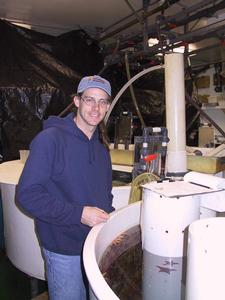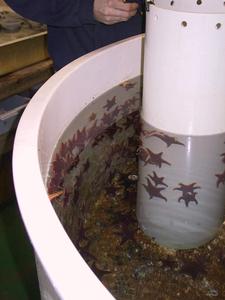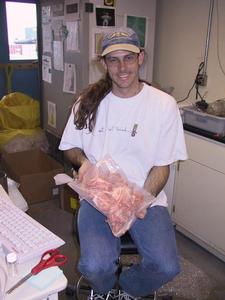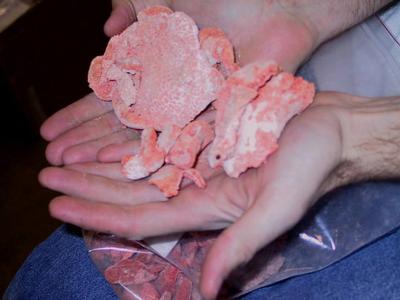22 January, 2002
IT LOOKS DELICIOUS, BUT WILL A STARFISH EAT IT ?
Chris Petrie is a graduate student at the University of South
Florida. He is also one of the divers who has been doing research here at
Palmer Station.
Chris is investigating the chemical defenses of sponges. He wants to see if
they make chemicals in their tissues so that other animals won't eat them.
Chris is using the starfish as a "test animal". That means he is finding
out what the starfish will eat, but he is really interested in finding the
chemical that makes a sponge less delicious to other animals. (And, he chose
the starfish as a test animal because this starfish will eat almost
anything!)
So, first Chris went out and collected a lot of starfish and he put them in
a big tank in the aquarium room.
Then Chris went diving to a depth of 100 feet and brought back a big red
sponge. He says that the skin of the sponge looks a lot like a football.
He fed pieces of the sponge to the starfish to see if they would eat it.
If the starfish didn't eat the sponge, then Chris took the sponge and soaked
it in chemicals. He analyzed this fluid to see what chemicals were in the
sponge tissues.
Then he made some test pellets out of some of the sponge chemicals, some
powdered krill, and alginic acid. (This is made from algae and it is used
like gelatin to bind things together. In fact, if you have ice cream in
your house, it probably has alginic acid in it, because that helps keep the
ice cream ingredients together.)
Then Chris fed the pellets to the starfish, to see if the starfish would eat
them. If they did eat the pellets, then he made different pellets with other
sponge chemicals in it. If they didn't eat the pellet, then he might have
found the chemical that the sponge makes as a defense. It would be a
chemical defense against being eaten by some other animal. Chris has found
a couple of sponge chemicals that the starfish decline to eat! When Chris
gets back to Florida, he will do more analysis on these chemicals!
Here's the math: the starfish live in a circular tank that is 780
centimeters (cm) high, and the water level in the tank is 120 cm down from
the top. The diameter of the tank is 2 meters. What is the volume of the
tank? (One liter equals 1,000 cubic centimeters.)

Chris Petrie beside the tank containing starfish.

This starfish has just been fed a pellet. Chris places the pellet on the underside of one of the starfish arms.

Here is another view of the starfish.

Chris and a package of freeze-dried sponges.

Ymmmm--freeze-dried sponges.
Contact the TEA in the field at
.
If you cannot connect through your browser, copy the
TEA's e-mail address in the "To:" line of
your favorite e-mail package.
|
